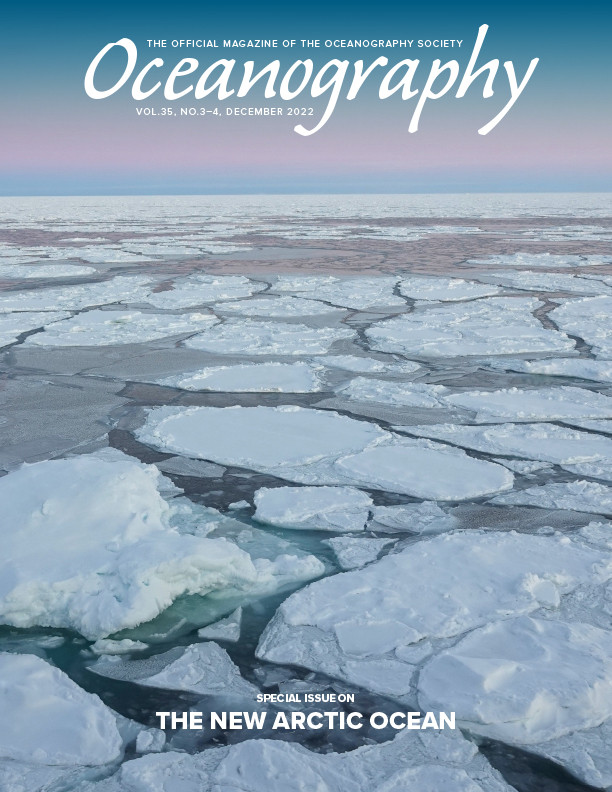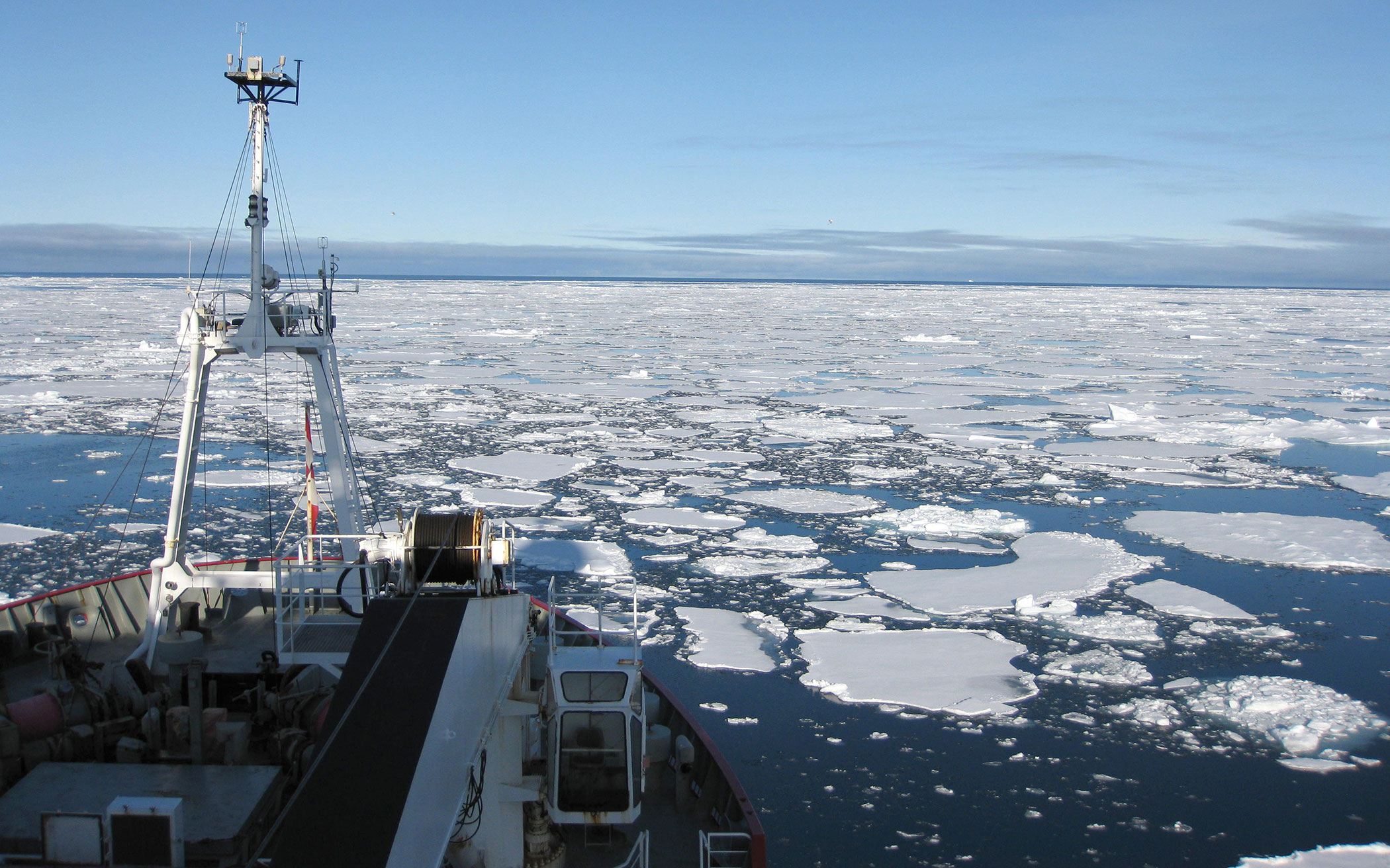Introduction
The Arctic Ocean plays a key role in regulating global climate. The high albedo of sea ice, which covers most of the Arctic Ocean, acts to cool the Northern Hemisphere. Waters of Atlantic and Pacific origin are transformed through cooling and freshening as they pass through the Arctic Ocean system. Over the past couple of decades, the Arctic has been warming at a greater pace than the global mean, with the clearest regional consequences being a rapid decline in sea ice extent and thickness.
Although the Arctic Ocean only accounts for about 1% of the global ocean by volume, it receives approximately 10% of global river discharge (Haine et al., 2015). Coupled with an excess of precipitation over evaporation and the seasonal ice freeze-melt cycle, this discharge results in an ocean that is predominantly salinity stratified—a layer of fresher water overlies saltier water, with a halocline between the two layers. The halocline plays a key role in isolating the main oceanic heat source, intermediate-depth Atlantic Water, from the sea surface and consequently sea ice. The fluxing of this intermediate-depth heat toward the surface, and hence its role in melting sea ice, is mediated by vertical exchange processes.
Across much of the global ocean, vertical exchange is dominated by turbulent stirring of gradients, which enhances mixing rates to many orders of magnitude above that of molecular diffusivity. Globally, the two main sources of mechanical energy supporting turbulent mixing are winds and tides, with the generation of internal waves providing a key energy pathway from forcing scales to the turbulent dissipation that supports mixing. The energy levels associated with the internal wave field are weak in the Arctic Ocean, several orders of magnitude below that typically observed at lower latitudes (Levine et al., 1987; Pinkel, 2005).
The weak internal wave field has been attributed to several factors unique to the Arctic Ocean. The direct wind forcing of the ocean is weakened on account of the decoupling of the ocean from the atmosphere by sea ice (Morison et al., 1985; Pinkel, 2005). Also, the high latitude of the Arctic Ocean prevents the generation of freely propagating linear internal tides (Vlasenko et al., 2003), a major source of turbulent mixing at lower latitudes. Furthermore, internal waves are frictionally damped on the underside of sea ice (e.g., Janout and Lenn, 2014; Carr et al., 2019).
A consequence of the Arctic Ocean’s weak turbulent mixing, combined with the opposing vertical heat and salt gradients across the halocline, is the formation of double diffusive staircases capping the intruding Atlantic Water across much of the interior of the Arctic Ocean (Padman and Dillion, 1987, 1988; Timmermans et al., 2008a; Fer, 2009; Guthrie et al., 2013; Sirevaag and Fer, 2012; Shibley et al., 2017). These staircases support weak vertical heat fluxes (0.02–0.30 Wm–2) that, Arctic-wide, are estimated to account for about 10% of the total heat flux to the sea ice, with seasonal solar heating dominating (Timmermans and Marshall, 2020).
Staircases support higher heat fluxes over the continental slope of the eastern Eurasian basin (~1 Wm–2; Polyakov et al., 2019). However, because they are not sufficient to explain the observed cooling and freshening of the intermediate-depth Atlantic Water along the shelf break, the presence of enhanced mixing processes that are episodic in space and time is likely (Lenn et al., 2009; Schulz et al., 2021b). A staircase cannot be sustained above a critical level of intermittent turbulence (Shibley and Timmermans, 2019), suggesting that the absence of staircases over continental slope regions in the western Eurasian Basin indicates significant turbulent mixing. Over the continental slope around the Yermak Plateau, vertical turbulent heat fluxes of up to 100 Wm–2 have been estimated (Padman and Dillon, 1991; D’Asaro and Morison, 1992; Meyer et al., 2017; Fer et al., 2020).
Here, we review recent studies of Arctic Ocean mixing processes, identifying key forcing mechanisms and energy pathways, and examine the changing impact of wind and stratification on turbulent mixing in an increasingly ice-free Arctic Ocean.
Wind-Driven Inertial Oscillations
Over recent decades, declining seasonal sea ice extent and the consequent increasing exposure of open water to surface wind stress have resulted in increased transfer of momentum from the atmosphere to the ocean on both basin (e.g., Giles et al., 2012; Armitage et al., 2017) and local scales (e.g., Rainville et al., 2011; Martini et al., 2014; Dosser and Rainville, 2016). Moreover, there is growing evidence of changes in wind-ice-ocean coupling in response to the changing nature of the sea ice associated with the widespread loss of thick, multiyear ice floes (Martin et al., 2014; Cole et al., 2017).
Observations from the shallow Chukchi and Laptev continental shelf seas reveal a pronounced seasonal signal in inertial currents and associated shear that is strongly correlated with the annual cycle of sea ice concentration and the passage of storms during open water periods (Rainville and Woodgate, 2009; Lenn et al., 2011). In both cases, the inertial currents were observed to penetrate the full water column (depth ~100 m), with an increasing phase lag with depth leading to enhanced shear, consistent with the structure of inertial currents observed in stratified temperate shelf seas (e.g., the North Sea; Knight et al., 2002).
A microstructure time series in the Laptev Sea indicates significant intermittency in midwater dissipation, with a three orders of magnitude increase following the alignment of the shear vector with the surface stress vector imposed by the movement of the sea ice (Lenn et al., 2011). These are consistent with a surface stress-shear alignment mechanism proposed for damping of inertial oscillations, and associated mixing, in temperate stratified shelf seas (Burchard and Rippeth, 2009).
While the ice-free shelf sea response to wind-driven inertial oscillations mirrors that at lower latitudes, within the central basins the depth penetration of the energy associated with inertial oscillations is limited on account of the high latitude position of the Arctic Ocean. At these latitudes, the gradient of planetary vorticity (β) is low, limiting depth penetration of the inertial shear (D’Asaro et al., 1995). A recent modeling study shows the combination of low β and shallow mixed layers can result in a sixfold reduction in near-inertial band energy in the Arctic Ocean as compared to similar mid-latitude scenarios (Guthrie and Morison, 2021). The inertial band energy is likely further reduced by the shoaling of the surface mixed layer (e.g., Timmermans et al., 2012).
Peralta-Ferriz and Woodgate (2015) show an almost ubiquitous shoaling of the surface mixed layer, of order 0.5–1 m yr–1, over the past three decades across all the major Arctic basins and in all seasons. The shoaling trends coincide with surface mixed layer freshening and increased stratification. The stratification is found to dominate over the wind in determining the surface mixed layer depth during ice-free periods (Peralta-Ferriz and Woodgate, 2015). There are also significant regional differences, with similar wind speeds two to three times more effective at deepening the surface mixed layer in the eastern Arctic Ocean than the more strongly stratified western Arctic (Peralta-Ferriz and Woodgate, 2015).
Polyakov et al. (2020a) report current measurements spanning 2004–2018 from the Nansen/Amundsen Basin Observation System (NABOS) mooring array in the eastern Arctic that show increasing inertial band current speeds and associated vertical shear in the upper water column, consistent with increasing coupling between the wind and upper ocean as sea ice declines. The strengthening shear coincides with weakening upper ocean stratification, indicating an increasing potential for shear instability and associated turbulent mixing. Over the same period, vertical heat fluxes are estimated to have almost trebled, overtaking the atmospheric heating contribution in the region (Polyakov et al., 2020b).
In contrast, a microstructure survey in the western Arctic during the 2012 Beaufort Gyre Exploration Program cruise, in open water and spanning the extraordinary Arctic cyclone of August 2012 (the strongest summer storm on record; Simmonds and Rudeva, 2012), found no evidence of enhanced mixing at depth, with the thermohaline staircases preserved throughout (Lincoln et al., 2016). They report mixing rates similar to those observed under sea ice (Padman and Dillon, 1987) and in more quiescent open water conditions (Fine et al., 2021). Dosser et al. (2021) reveal a strengthening seasonal cycle in dissipation in the Canada Basin between 2004–2010 and 2011–2019, with an estimated doubling in summer. While this implies increasing heat fluxes, they are still too low to melt meaningful quantities of sea ice. They also find a decrease in winter dissipation that they attribute to reduced wind-ice-ocean drag in response to the loss of thick, multiyear ice floes.
Tides
Stratified tidal flow over sloping topography results in the conversion of energy into an internal tide, a key energy pathway from tides to turbulent mixing. The downslope stratified flow results in the depression of the pycnocline, which, as the tide slackens, propagates away as a linear internal wave of tidal period. However, much of the Arctic Ocean is located poleward of the critical latitude at which the local inertial period matches the dominant (M2) tidal period, and so the resulting lee wave becomes bottom trapped. A consequence is a significant reduction in the efficiency of tidal conversion at these high latitudes (Vlasenko et al., 2003).
A major hotspot for enhanced midwater dissipation has been identified over the continental slope north of Svalbard and the Yermack Plateau (Padman and Dillion, 1991; D’Asaro and Morison, 1992; Fer et al., 2015; Koenig et al., 2021) that is associated with the cross-slope flowing tide (Fer et al., 2020). Here, midwater dissipations are found to be enhanced by a factor of 100, resulting in turbulent heat fluxes toward the surface of O(10 Wm–2). Similarly enhanced heat fluxes have been reported over sloping topography in the Beaufort Sea and extending into the Chukchi Sea (W.J. Shaw et al., 2009).
Pan-Arctic microstructure measurements show hotspots of enhanced midwater dissipation over the continental slope that correlate spatially to areas of significant tidal conversion (Figure 1), implicating the tide as a significant source of energy supporting enhanced mid-water dissipation (Rippeth et al., 2015). Fer et al. (2020) estimate that, Arctic wide, the contribution of the tides to the diapycnal heat flux is comparable to that of double diffusion, despite their limited geographical extent.
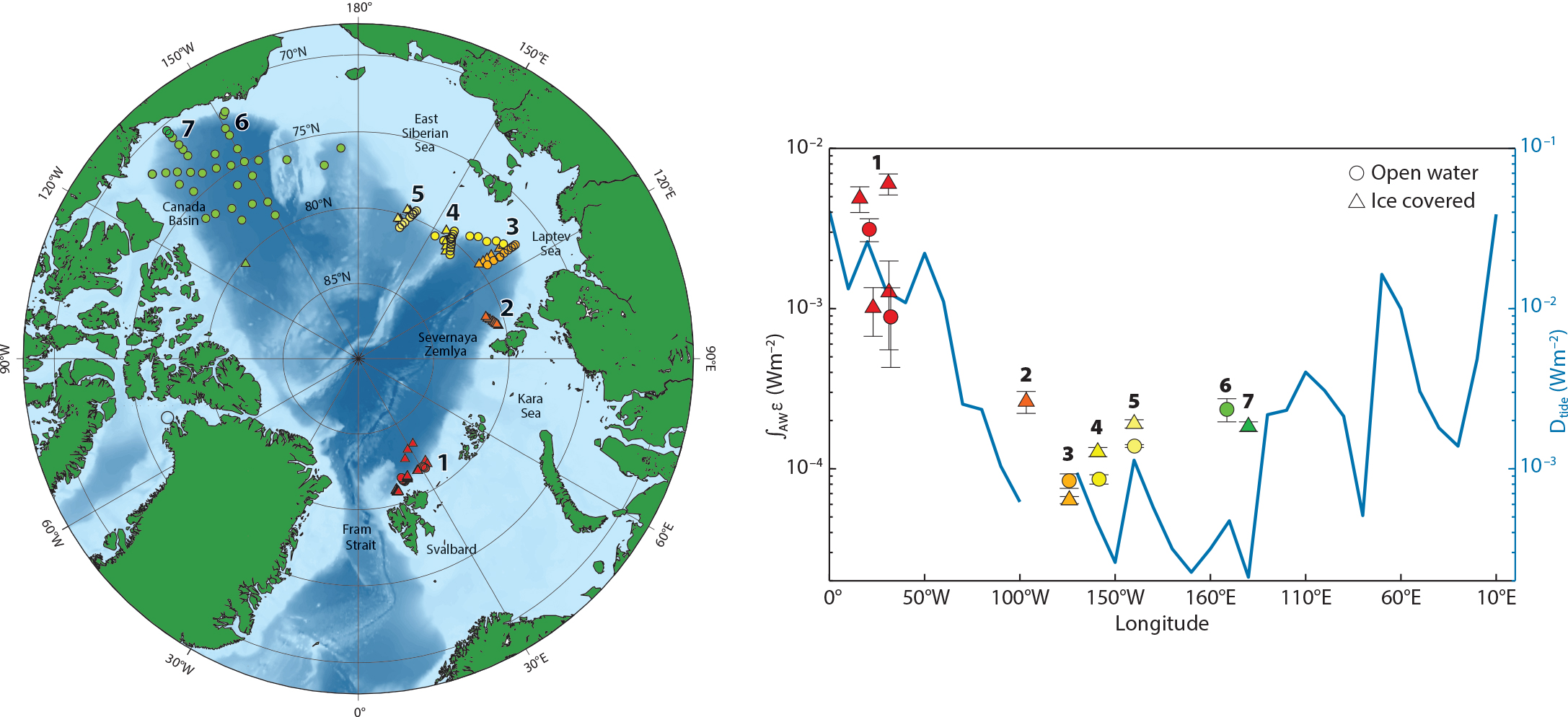
FIGURE 1. The circumpolar rate of tidal energy dissipation (D) over the continental shelf break around the Arctic Ocean. The solid line is the estimated rate of conversion of tidal energy to turbulence using altimeter data, and the symbols represent transect average midwater dissipation measurements (∫AWε) based on microstructure surveys. The circles indicate measurements made in open water conditions while the triangles indicate measurements under significant local ice cover. The Arctic map shows the positions of the transects. Redrawn from Rippeth et al. (2015). > High res figure
|
Due to the critical latitude constraints, the energy pathway from tides to turbulence poleward of the critical latitude is nonlinear and results from the formation of an unsteady lee wave of length scale comparable to the bottom topography (Rippeth et al., 2017). A consequence of relatively slow internal wave phase speeds is that the downslope flow can become supercritical, introducing a direct nonlinear energy pathway from the tide to turbulence (Rippeth et al, 2017; Hughes and Klymak, 2019; Fer et al., 2020). Toward the end of the downslope flow, the lee wave disintegrates into a packet of freely propagating nonlinear internal waves (Rippeth et al., 2017; Figure 2). Synthetic aperture radar imagery reveals widespread nonlinear internal waves over continental shelf and slope regions in the eastern Arctic (Koslov et al., 2017; Koslov and Zubkova, 2019; Rippeth et al., 2019; Marchenko et al., 2021) that have potential to dissipate to turbulent mixing further afield.
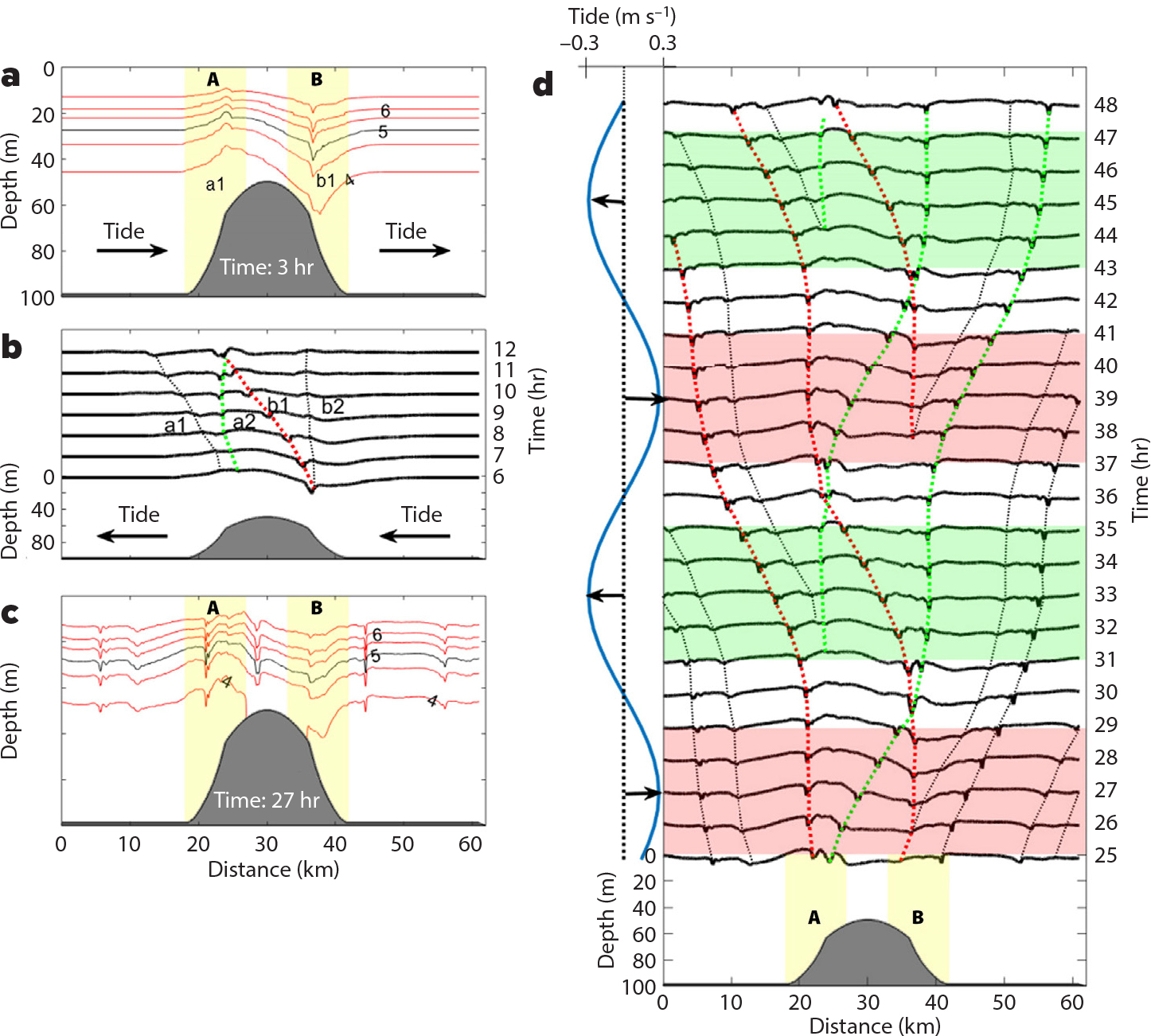
FIGURE 2. Simulated cross-bank M2 tidal flow and evolution of stratification over Spitsbergen Bank (poleward of the critical latitude for the M2 tide) constructed using a non-hydrostatic high-resolution version of the MIT general circulation model. The plots show the predicted temperature fields (4°–6.5°C isotherms at 0.5°C intervals) after (a) 3 hr and (c) 27 hr of model time. They illustrate the development of a lee wave downstream of the flow and its breakup into high frequency internal waves. The evolution of the 5° isotherm is shown in the Hovmöller diagrams: (b) t = 6–12 hr and (d) t = 25–48 hr periods of simulation with a contour interval of 1 hr. The green and red dotted lines identify the internal waves radiating away from the topography. The direction and strength of the tidal flow is shown as a solid blue line. The generation zones A and B are shaded yellow in panels (a), (c), and (d). The red and green regions in (d) indicate periods of time when the flow associated with the development of the lee wave is supercritical (Fr > 1). Reproduced from Rippeth et al. (2017). > High res figure
|
Remotely Forced Wind Mixing
Schulz et al. (2021a) observe significantly enhanced midwater dissipation over the continental slope poleward of the Laptev Sea, an area with weak tides (Fer et al., 2020) and low tidal conversion (Rippeth et al., 2015). Microstructure profiles reveal levels of dissipation several orders of magnitude above background that coincide with a downslope flow (maximum depth-averaged velocities ~0.5 ms−1) and depression in the isopycnals, both of which are consistent with the passage of a continental shelf wave (CSW; Danielson et al., 2020). Schulz et al. (2021a) propose that the downslope barotropic flow associated with a CSW results in the development of an unsteady lee wave, implying an energy pathway to midwater dissipation similar to that of the tide.
Although some coastal sea level anomalies are a local response to propagating storms, others propagate eastward in the Arctic as CSWs of period 2–6 days. In the eastern Arctic, they tend to be generated in the Fram Strait/Barents Sea and propagate through the Kara Sea and then the Laptev Sea about one day later (Danielson et al., 2020). Danielson et al. (2020) estimate an average of 12 CSWs per year, while Shultz et al. (2021a) show that CSWs in the Laptev Sea are almost exclusively found during periods of reduced sea ice extent, pointing to enhanced far-field induced mixing during periods of reduced sea ice, particularly in the eastern Arctic.
Eddies, Submesoscale Dynamics, and Lateral Processes
Eddies are ubiquitous in the global ocean. They not only transport water properties but also act to stir water along isopycnals as they propagate, eroding large-scale gradients and contributing to diapycnal mixing. Eddies are frequently observed in the Arctic Ocean (Hunkins, 1974; Newton et al., 1974; among many others) and are typically intensified in the halocline. In many cases, eddies transport water originating in the Arctic shelf seas to the basin interior and so represent an important mechanism for ventilating the Arctic halocline (Muench et al., 2000; Spall et al., 2008).
The halocline intensification of eddies means the largest eddy velocities are frequently subsurface, which, combined with relatively small diameters (due to the high latitude), makes satellite detection difficult. Manley and Hunkins (1985) estimated that up to one-fourth of the Beaufort Sea (by area) may be filled with eddies based on profiles collected from drifting ice camps in 1975–1976. More recently, observations collected from Ice-Tethered Profilers (ITPs), hydrographic cruises, and moorings have identified hundreds of eddies (Zhao et al., 2014; Zhao and Timmermans, 2015; Zhao et al., 2018). They are predominantly anticyclonic and are mostly cold and fresh relative to the surrounding water. Kozlov et al. (2019) identified thousands of eddies from synthetic aperture radar data of which 65%–70% were cyclonic, in contrast to the preponderance of anticyclonic eddies reported from subsurface measurements. In the Eurasian basin, mooring-based studies show a nearly even split between cyclones and anticyclones (Pnyushkov et al., 2018).
Multiple formation mechanisms have been proposed to explain the origins of Arctic eddies, which are observed more frequently in regions close to topographic boundaries (Zhao et al., 2014; Zhao and Timmermans, 2015; Kozlov et al., 2019). An early proposal suggested formation due to frontal or baroclinic instability (Hunkins, 1974). Spall (1995) described a theory of eddy formation based on frontal instability that leads to subduction and generates eddies along fronts, which is consistent with observations from the northern edge of the Beaufort Gyre (Timmermans et al., 2008b; Manucharyan and Timmermans, 2013), meltwater fronts surrounding the marginal ice zone (Lu et al., 2015; Manucharyan et al., 2017), and ice edge jets (Heorton et al., 2014; Bulczak et al., 2015). More recently, MacKinnon et al. (2021) observed the subduction of an offshore jet of warm water originating from Barrow Canyon and the formation of eddies that appear to conserve potential vorticity during the subduction process (Figure 3). While (usually cyclonic) surface eddies can also form due to frontal and baroclinic instabilities, friction at the ice-ocean boundary provides a mechanism that decays the surface eddy velocity more rapidly than the subsurface signature, leaving a field of mostly intrahalocline eddies (Ou and Gordon, 1986; Meneghello et al., 2021). This observation may explain the apparent discrepancy between the satellite observations of Kozlov et al. (2019), which show a preponderance of cyclonic eddies in surface measurements in ice-free waters and the marginal ice zone, and observations of the dominance of anticyclones in subsurface measurements in the central basins (e.g., Zhao et al., 2014).
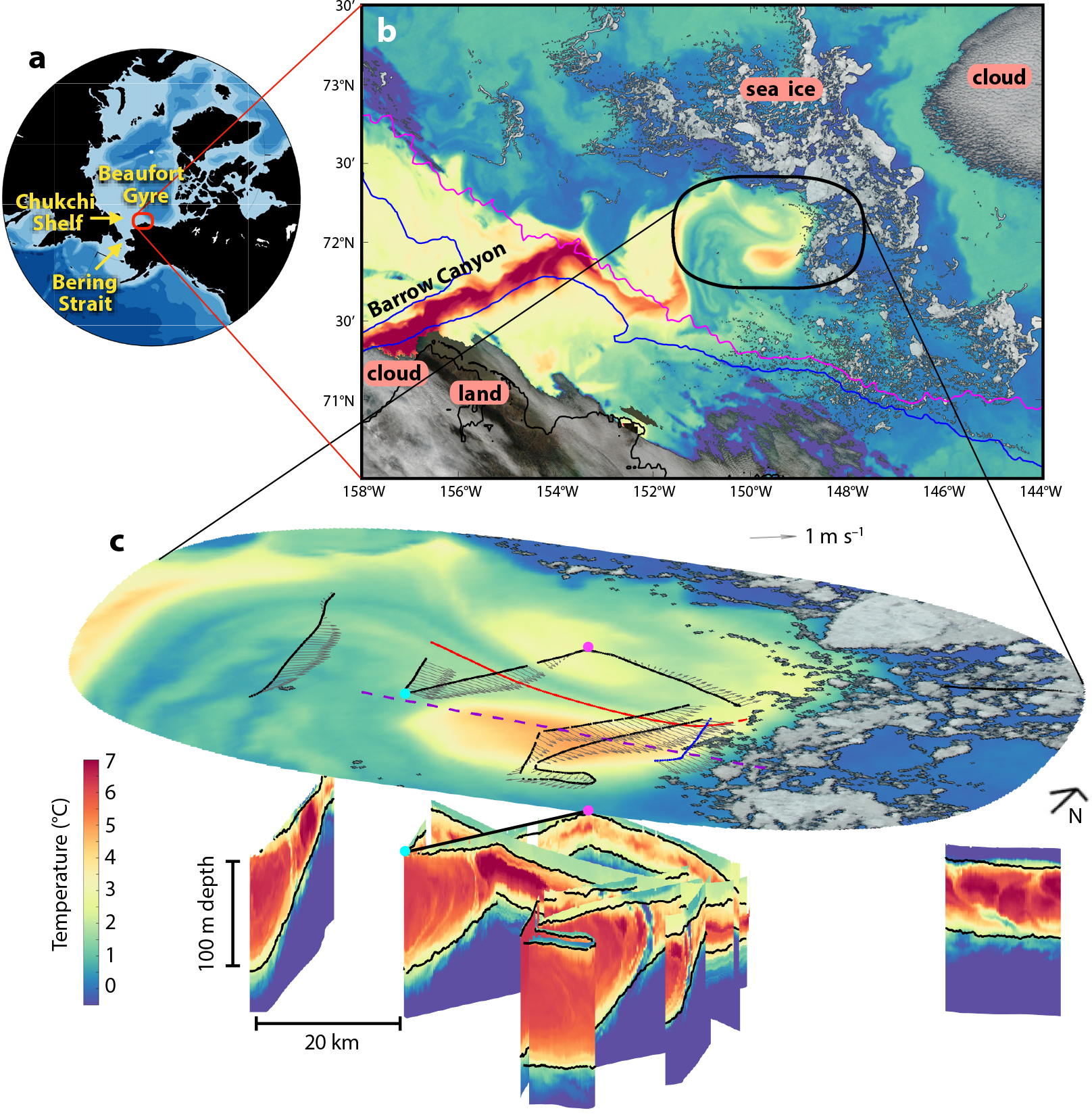
FIGURE 3. Novel high-resolution observations of the subduction and initial evolution of warm Pacific-origin water in the southern Beaufort Gyre, emphasizing the scale of these phenomena. (a) In a map of the western Arctic, the red square indicates the locations of panels (b) and (c). (b) The surface temperature signal from a hybrid MODIS satellite image collected on September 15, 2018, shows sea ice and clouds in true color and sea surface temperature (SST) in open water. The black line traces the Alaskan coast at lower left, and the 100 m and 1,000 m isobaths are shown in blue and magenta, respectively. (c) An expanded view of SST is imaged along with subsurface temperature measurements taken September 14–17, 2018, emphasizing the halocline intensification of the eddy. Observed ocean current vectors averaged over the upper 90 m are shown. The dashed purple line tracks the second FastCTD survey nine days later (shown to the bottom right). The solid black lines on the temperature contour plots indicate the 23.2 kg m−3 and 25.2 kg m−3 potential density surfaces. Redrawn from MacKinnon et al. (2021). > High res figure
|
Boundary currents may also generate eddies on their flanks through baroclinic instability, as frequently observed on the Beaufort shelfbreak jet (Pickart, 2004; Pickart et al., 2005; Spall et al., 2008), and can result in the cooling of the current, as observed in the Chukchi slope current (Boury et al., 2020). Direct interactions of flows with topography may also generate eddies (D’Asaro, 1988; Cenedese and Whitehead, 2000; Chao and Shaw, 2003; P.T. Shaw and Chao, 2003; Pickart et al., 2005).
Eddies play a key dynamical role in sustaining the Beaufort Gyre. Surface Ekman convergence results in buildup of freshwater in the gyre’s center. As isopycnals steepen, they become increasingly susceptible to baroclinic instability, which results in the release of relatively cold, fresh eddies from the gyre. To maintain steady state, the rate of eddy generation must balance the net transport of surface Ekman convergence over the western Arctic (Manucharyan and Spall, 2016). Furthermore, eddies’ role in balancing the gyre is affected by a feedback mechanism between gyre speed and stress at the ice-ocean interface, which results in a balance between Ekman transport, eddy fluxes, and ice-ocean stress (Meneghello et al., 2018; Doddridge et al., 2019). Satellite-derived estimates of geostrophic currents under sea ice indicate that the eddy field has become an increasingly important contributor to this balance as sea ice decline has reduced ice-ocean stress in recent years (Armitage et al., 2020).
Eddies can intensify vertical mixing by locally focusing both the internal wave field and double diffusive convection. Anticyclonic eddies have low potential vorticity signatures, so that the effective Coriolis frequency within an anticyclonic eddy is subinertial. Consequently, the internal waves cannot propagate out of these eddies and instead encounter critical layers where they dissipate (Kunze, 1985). Arctic eddies have been observed to interact with the internal wave field (Halle and Pinkel, 2003; Cole et al., 2017), and Kawaguchi et al. (2014, 2016) attribute this to elevated midwater dissipation.
The hydrographic structure of warm eddies can also result in double diffusive processes that elevate turbulence and generate heat and salt fluxes from the eddy. This has been observed in both deeper Atlantic Water eddies (Dmitrenko et al., 2008; Bebieva and Timmermans, 2015) and in shallower Pacific Summer Water eddies (Kawaguchi et al., 2012; Fine et al., 2018). Double diffusion acts to transport heat upward from the tops of warm eddies and downward from their bases. Bebieva and Timmermans (2015) estimated an upward heat flux of 0.15 Wm–2 due to diffusive convection and a downward heat flux of 0.8 Wm–2 due to salt fingering. Pacific Summer Water eddies are substantially warmer, and Fine et al. (2018) used microstructure measurements to estimate an upward heat flux of 5 Wm–2 from an eddy on the Chukchi slope and a downward flux of 0.5 Wm–2. Furthermore, the double diffusive heat fluxes associated with warm eddies may intensify as source waters warm.
Discussion
A longstanding paradigm regarding the changing Arctic Ocean is that turbulent mixing will increase as a result of increased atmosphere-ocean coupling as sea ice declines (Figure 4). However, studies over the past decade have highlighted contrasting impacts of increased atmospheric coupling across different regions. Over the continental shelves, the open water response matches that at lower latitudes, resulting in a strengthening seasonal mixing cycle in response to declining seasonal sea ice extent, which in turn impacts atmospheric heat uptake, the duration of seasonally ice-free periods, and the properties of shelf waters exported to basin interiors.
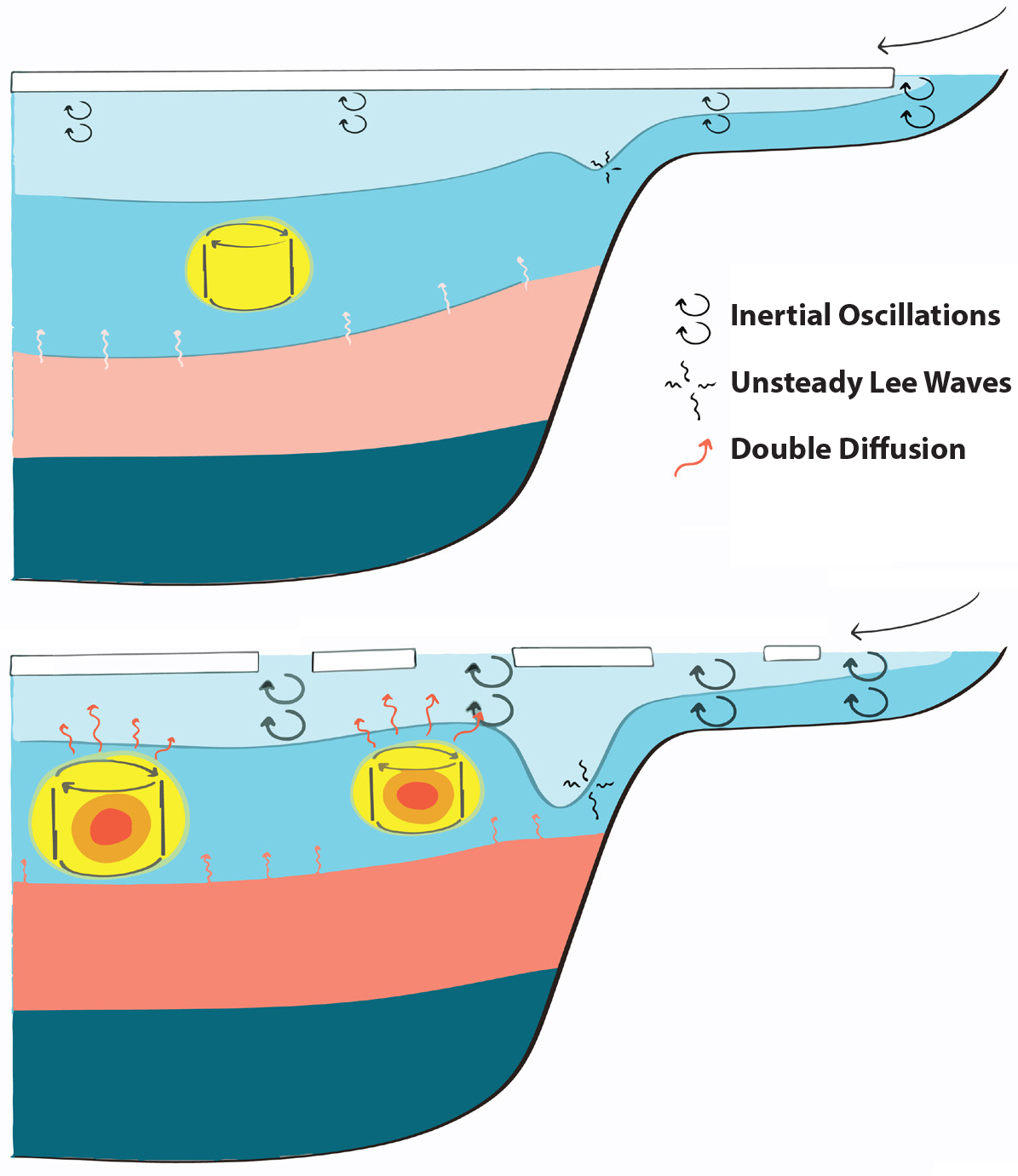
FIGURE 4. Schematic outlining the changes in turbulent mixing in a changing Arctic Ocean. Increasing ocean-atmosphere coupling combined with changes in stratification are altering the continental shelf mixing regimes, with some evidence of changing mixing patterns in the eastern Arctic Basin. Eddies are recognized as playing an increasing role in both the transport of shelf water and mixing, while the tide and far-field storms are implicated in driving mixing over the continental shelf break via the unsteady lee wave mechanism. > High res figure
|
In the ocean basins, shoaling surface mixed layers and high latitude conspire to limit the depth penetration of near-inertial energy (Guthrie and Morison, 2021). The shoaling of the surface mixed layer is predominantly a result of stratification changes and is linked to the large-scale dynamics through changes in freshwater budgets (Peralta-Ferriz and Woodgate, 2015). There is also strong evidence of differing responses across the eastern and western basins.
In the eastern Eurasian basin, a new positive feedback mechanism is identified in which reduced sea ice extent promotes more energetic inertial currents, leading to increased ventilation of the Atlantic Water and increased sea ice melt (Polyakov et al., 2020a). The enhanced mixing is a consequence of increasing inertial band currents combined with weakening upper ocean stratification (Polyakov et al., 2020b). Over the past decade, the changing stratification in this region is partly explained by changes further afield, including the warming and increasing salt content of the inflowing Atlantic Water (Polyakov et al., 2017, 2020b; Barton et al., 2018).
In contrast, in the western Arctic, the intermediate-depth oceanic heat reservoirs remain relatively isolated from the surface mixed layer by halocline stratification, ensuring negligible ice-Atlantic Water heat feedback (Lincoln et al., 2016; Dosser et al., 2021; Fine et al., 2021). However, heat that has been accumulating in the halocline for the past three decades is linked to a fivefold increase in summer heat absorption associated with reduced sea ice coverage in the northern Chukchi Sea (Timmermans et al., 2018), emphasizing the potential for the changing shelf mixing environment to impact sea ice coverage in the central basins.
Although much of the Arctic lies poleward of the critical latitude where freely propagating linear internal tides cannot be generated, the role of tides in driving turbulent mixing in the Arctic Ocean has been increasingly recognized. While the geographical influence of tidal mixing is largely limited to the shelf and shelf break (Rippeth et al., 2015; Fer et al., 2020), the latter forms an important pathway for the intruding warm Atlantic and Pacific waters. The main mechanism identified for the conversion of tidal energy to midwater turbulence is the formation of unsteady lee waves, with the development of near-critical and supercritical flow dominating tidal conversion (Rippeth et al., 2017). Both processes are stratification dependent. In particular, the weakening of upper ocean stratification could lengthen periods of enhanced mixing (Fer et al., 2020) and thus increase the rate of tidal conversion, with potential for extension to regions of weaker tides.
Tides can also interact with other mechanisms to enhance midwater mixing. These could include continental shelf waves (Schulz et al. 2021a) and variations in background flow (e.g., Aksenov et al., 2011). Accordingly, temporal and spatial changes in any of these phenomena, for example, linked to changing storminess, stratification, or sea ice decline, will impact future geographic extent of associated midwater mixing over sloping topography. While unsteady lee waves provide a major source of midwater mixing, they have relatively short length scales and so are not resolved in current state-of-the-art regional ocean models or climate simulations, emphasizing the need for their parameterization.
Eddies are also shown to make an important contribution to setting water column properties. Armitage et al. (2020) and Doddridge et al. (2019) suggest that as sea ice drag has decreased due to sea ice decline, eddy kinetic energy has increased, as increased Ekman convergence leads to steepening isopycnals, which are then susceptible to baroclinic instability. An increase in lateral stirring by eddies could substantially impact stratification, particularly where vertical mixing is weak. Observations by MacKinnon et al. (2021; Figure 3) emphasize the small horizontal scales associated with eddies, which are not resolved by regional forecast models or climate simulations, underscoring the need for the development of new eddy mixing parameterizations to improve the predictive skill of these models.
Although this review focuses on the role of turbulence in stirring up intermediate-depth heat, inflowing Atlantic and Pacific waters are also the main supply of nutrients to the Arctic Ocean (Torres-Valdes et al., 2013). Consequently, the changing mixing patterns, coupled with changes in stratification, may directly impact primary productivity. As seasonal sea ice has declined, net primary productivity has increased by at least 30%, with a particularly strong response in the eastern Arctic Ocean where a 110% increase in primary productivity is reported over the Laptev Sea shelf break region (Arrigo and van Dijken, 2015). This is a region of recent increasing near-inertial currents and declining upper ocean stratification (Polyakov et al., 2020a,b) and where midwater depth mixing events are intermittent (Shultz et al., 2022). The impact of changing mixing patterns and stratification on limiting nutrient fluxes together with knock-on effects on primary production, the food web, and carbon sequestration is an important area of ongoing work.
Acknowledgments
Tom Rippeth’s interest in the Arctic has been funded through 2 UKRI NERC Consortia (Asbo and Teacosi), and more recently through the UKRI NERC - German Federal Ministry for Science and Education (BMBF) Changing Arctic Programme PEANUTS project. Effie Fine’s interest in the Arctic has been supported by the US National Science Foundation’s Graduate Research Fellowships Program and Office of Polar Programs, by the Office of Naval Research, and by the Postdoctoral Scholar Program at Woods Hole Oceanographic Institution, with funding provided by the Weston Howland Jr. Postdoctoral Scholarship.

